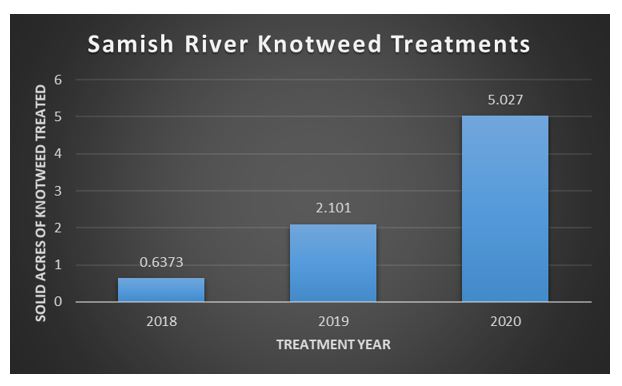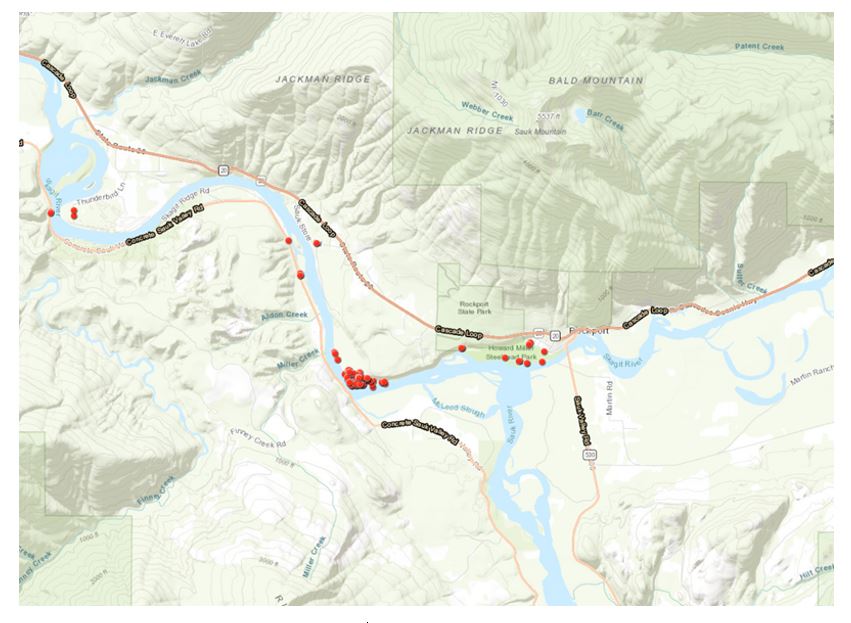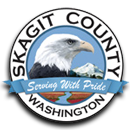Noxious Weeds
Grant Programs |
| The Skagit County Noxious Weed Control Board (SCNWCB) has two grant based programs that are both funded through Washington State Department of Agriculture (WSDA). The Spartina Program and the Knotweed Control Program. |
SPARTINA ANGLICA |
| Spartina anglica (Common cordgrass) is a perennial saltmarsh grass native to Northern Europe. Originally listed as a noxious weed in 1990, it is a Class A species that is required to be controlled in Washington State and is on the state quarantine list (please see WAC 16-752 for more information). Spartina displaces native species, destroys habitat and food for fish, waterfowl, and other marine life. Interferes with recreational activities and is difficult to control. The SCNWCB began efforts to control Spartina in 1997 and has seen a great overall reduction in total plant populations. Due to the abundance and persistent nature of this species, control can be challenging. Every year the SCNWCB coordinates cooperation efforts with WSDA, Padilla Bay Natural Estuarine Research Reserve (PBNERR), Swinomish Tribal Nation (STN), Whatcom County Noxious Weed Control Board, Snohomish County Noxious Weed Control Board, Island County Noxious Weed Control Board, and Washington State Department of Fish and Wildlife. Surveys and treatment for this species beings in June and ends in October. |
 |
| Graph 1.) The total square feet of Spartina anglica treated by the SCNWCB over three years. The treatment increase in 2020 is due to the integration of data with the Padilla Bay Natural Estuarine Research Reserve (PBNERR) and the Swinomish Tribal Nation (STN). |
 |
| Map 1.) The red dots represent Spartina plants that were treated in Skagit County in 2020 by the SCNWCB. |
|
NWCB Information on Spartina |
KNOTWEED |
|
The SCNWCB has been working to control knotweed on Grandy Creek and Samish River since 2013. Knotweed populations on Grandy Creek have been steadily declining due to its relatively small landowner base. The Samish River system encompasses a much larger area, so the SCNWCB has been focusing on the portion that lies east of Old Highway 99. When working with knotweed species in a water system, it’s important to take a top-down approach. This ensures treated areas downstream aren’t at risk of being recolonized by populations upstream. Due to this method, knotweed treatment numbers on the Samish River have been increasing over the last several years as the program progresses downriver (Graph 3). Knotweed control on the Skagit River is a cooperation effort between SCNWCB and the Skagit Cooperative Management Area Group (CWMA) which includes the Washington Department of Fish and Wildlife (WDFW), the Washington State Department of Natural Resources (DNR), North Cascades National Park (as governed by the National Park Service, US Department of the Interior), Skagit Fisheries Enhancement Group, Skagit Land Trust, Seattle City Light, Snohomish County Noxious Weed Control Board, Whatcom County Noxious Weed Control Board, the Nature Conservancy (TNC) and the Samish Indian Tribe. NWCB Information on Knotweed |
 |
| Graph 2.) The total solid acres of knotweed treated by the SCNWCB on Grandy Creek over three years. |
 |
| Map 2.) The red dots represent knotweed plants that were treated on Grandy Creek in 2020 by the SCNWCB. |
 |
| Graph 3.) The total solid acres of knotweed treated by the SCNWCB on Samish River over three years. |
 |
| Map 3.) The red dots represent knotweed plants that were treated on Samish River in 2020 by the SCNWCB. |
 |
| Graph 4.) The total solid acres of knotweed treated by the SCNWCB on the Skagit River over two years. |
 |
| Map 4.) The red dots represent knotweed plants that were treated on the Skagit River in 2020 by the SCNWCB. |




